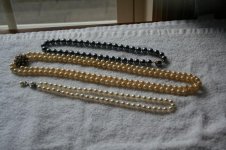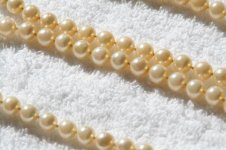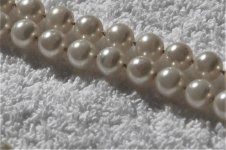When my mother passed she left some pearls to my wife. We actually forgot about them until yesterday when we purchased another strand and found these when she went to put the new ones away. These strands had not seen daylight in probably 15+ years and I thought it prudent to "gently" clean them in a dilute solution of dish soap and spring water with a spring water rinse using microfiber cloths. I photographed the strands prior to cleaning but didn't think to zoom in close. After the cleaning I noticed on what I believe was here oldest an favorite necklace (center) substantial damage to the outermost Nacre. My question is if I didn't notice this level of finish erosion prior to the cleaning is it likely I did something wrong? I ask because I had planned to clean other small strands my wife has accumulated over the years and don't want similar results. Thank you for any advice!!
You are using an out of date browser. It may not display this or other websites correctly.
You should upgrade or use an alternative browser.
You should upgrade or use an alternative browser.
Are these dead?
- Thread starter massrog
- Start date
Pearl Dreams
Pearl Enthusiast
- Joined
- Sep 24, 2007
- Messages
- 9,527
I just replied to your PM but you found the forum where to post this on your own.  I'll repeat what I messaged you here about how to clean pearls:
I'll repeat what I messaged you here about how to clean pearls:
As to cleaning methods, we don't recommend using liquid dish soap to wash pearls, even diluted-- it's too harsh. Dish "soap" is actually a detergent. For that matter liquid hand "soaps" are also detergents, as are shampoos and shower gels. Detergents generally are too harsh for pearls. Soaps are better. Chemically, detergents and soaps are different. Most folks don't know this, and common usage doesn't help.
A good choice for cleaning pearls is unscented Dr. Bronner's liquid soap (which is actually a soap, not a detergent) or any mild bar soap swished around in distilled or filtered water. Distilled water is best as it doesn't contain the minerals that are often present in ground water, which interact with soap (but not with detergent) to form a hard-to-remove scum.
In the past I have also used baby wash to clean pearls, which is technically a detergent but is very mild. But nowadays I stick to Bronner's and distilled water.
As to your photos, I don't see what you are seeing. The contrast in the photo is too high. Try again?
As to cleaning methods, we don't recommend using liquid dish soap to wash pearls, even diluted-- it's too harsh. Dish "soap" is actually a detergent. For that matter liquid hand "soaps" are also detergents, as are shampoos and shower gels. Detergents generally are too harsh for pearls. Soaps are better. Chemically, detergents and soaps are different. Most folks don't know this, and common usage doesn't help.
A good choice for cleaning pearls is unscented Dr. Bronner's liquid soap (which is actually a soap, not a detergent) or any mild bar soap swished around in distilled or filtered water. Distilled water is best as it doesn't contain the minerals that are often present in ground water, which interact with soap (but not with detergent) to form a hard-to-remove scum.
In the past I have also used baby wash to clean pearls, which is technically a detergent but is very mild. But nowadays I stick to Bronner's and distilled water.
As to your photos, I don't see what you are seeing. The contrast in the photo is too high. Try again?
Last edited:
Pearl Dreams
Pearl Enthusiast
- Joined
- Sep 24, 2007
- Messages
- 9,527
I just want to add that you should test to be sure they are actually real pearls. The reason I say that is that the dark strand looks like Majorica imitation pearls to me-- the clasp is typical of Majorica clasps in the early 1990s. At least, viewed from this distance. Also the pearls are all the same size, which is not typical of Tahitian strands.
Rub one pearl gently against another pearl, or against the edge of your front tooth. If they glide smoothly, that is indicative of imitation pearls. Real nacre has a slightly gritty feel when rubbed this way.
If they are imitation then you may just be seeing the coating peeling away to reveal the glass bead within. 'this would not be surprising as they were obviously well loved and worn a lot, judging from the dirty knots.
Ladies of that generation often owned imitation pearls. My mother had a Majorica strand she treasured and wore constantly in her final years. For that matter, Jackie Kennedy's famous 3 strand pearl necklace was imitation, as were Barbara Bush's pearls.
Check the clasps for any marks indicating the metal or manufacturer.
Rub one pearl gently against another pearl, or against the edge of your front tooth. If they glide smoothly, that is indicative of imitation pearls. Real nacre has a slightly gritty feel when rubbed this way.
If they are imitation then you may just be seeing the coating peeling away to reveal the glass bead within. 'this would not be surprising as they were obviously well loved and worn a lot, judging from the dirty knots.
Ladies of that generation often owned imitation pearls. My mother had a Majorica strand she treasured and wore constantly in her final years. For that matter, Jackie Kennedy's famous 3 strand pearl necklace was imitation, as were Barbara Bush's pearls.
Check the clasps for any marks indicating the metal or manufacturer.
Last edited:
Pearl Dreams
Pearl Enthusiast
- Joined
- Sep 24, 2007
- Messages
- 9,527
They look fake to me. Did you do the tooth test?
Cheap fakes have one layer of pearly coating and underneath is the glass bead (or plastic, if really cheap.) Better fakes like Majorica have multiple layers of coating. The final coating creates a sort of pseudo-iridescence.
Also, reread my second post as I edited it.
Cheap fakes have one layer of pearly coating and underneath is the glass bead (or plastic, if really cheap.) Better fakes like Majorica have multiple layers of coating. The final coating creates a sort of pseudo-iridescence.
Also, reread my second post as I edited it.
Aha!!!! Well at least the clasp is 14k with real Opals! Boy do I feel dumb. Is the term Majorca indicative of their Origin? If so it makes sense they went there a couple of times. I was wondering why the "Tahitians" and these felt a little tacky when cleaning and the lighter ones with white clasp didn't. Of the three only the lighter ones felt gritty. At least I saved a TON on stringing fees lol! Thanks again you are a great tutor!
On a side note how do you think the Opal clasp would look on the wife's new 12-14mm strand?
On a side note how do you think the Opal clasp would look on the wife's new 12-14mm strand?
Pearl Dreams
Pearl Enthusiast
- Joined
- Sep 24, 2007
- Messages
- 9,527
Good! Now you know which ones are real. Don't feel dumb! Good imitations are meant to fool the eye.
Majorica (with the i) is indeed a brand with the factory located in Spain (but they are sold widely.) See this older article on Majorica brand in a 1990 GIA Gems & Gemology issue: https://www.gia.edu/doc/FA90.pdf
Majorica being famous as a brand has imitators, including Joia de Majorca, Mallorca and others. On eBay I've noticed sellers tend to use the word generically to mean imitation pearls, the way we use Bandaids or Kleenex or Jello generically, even though they are actual brand names.
Now as to the clasp. It is for a two-strand necklace, so it would have to be adapted for use with the newest strand.
Majorica (with the i) is indeed a brand with the factory located in Spain (but they are sold widely.) See this older article on Majorica brand in a 1990 GIA Gems & Gemology issue: https://www.gia.edu/doc/FA90.pdf
Majorica being famous as a brand has imitators, including Joia de Majorca, Mallorca and others. On eBay I've noticed sellers tend to use the word generically to mean imitation pearls, the way we use Bandaids or Kleenex or Jello generically, even though they are actual brand names.
Now as to the clasp. It is for a two-strand necklace, so it would have to be adapted for use with the newest strand.
CathyKeshi
Well-known member
- Joined
- Mar 16, 2014
- Messages
- 4,614
massrog, looks like you have had great help investigating your mystery strands. Just my opinion: I think that opal/gold clasp would look fabulous on your wife's new 12 - 14mm strand! Cleaned up, sparkling, and new pearls, fabulous, and not outdated at all. Many of us collect and/or search long and hard for unique clasps to accent the beauty of pearls. A clasp like that can be work at the back of the neck for a subtle, secret touch, or on the side for added sparkle for a dressier occasion ... practical indeed 
Pearl Dreams
Pearl Enthusiast
- Joined
- Sep 24, 2007
- Messages
- 9,527
Three loops, great! Go for it!
Similar threads
- Replies
- 6
- Views
- 829
- Replies
- 2
- Views
- 1K
- Replies
- 333
- Views
- 23K
- Replies
- 9
- Views
- 3K
- Replies
- 17
- Views
- 2K



